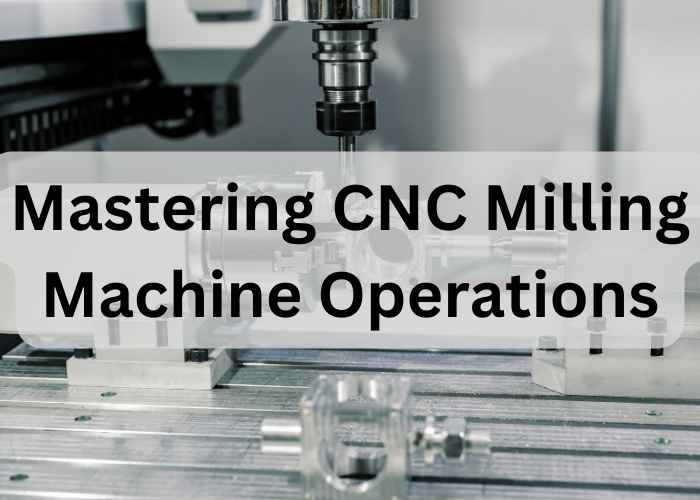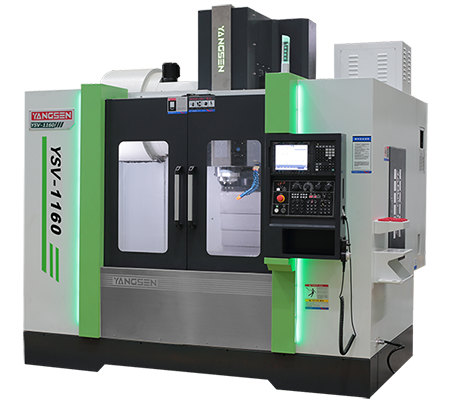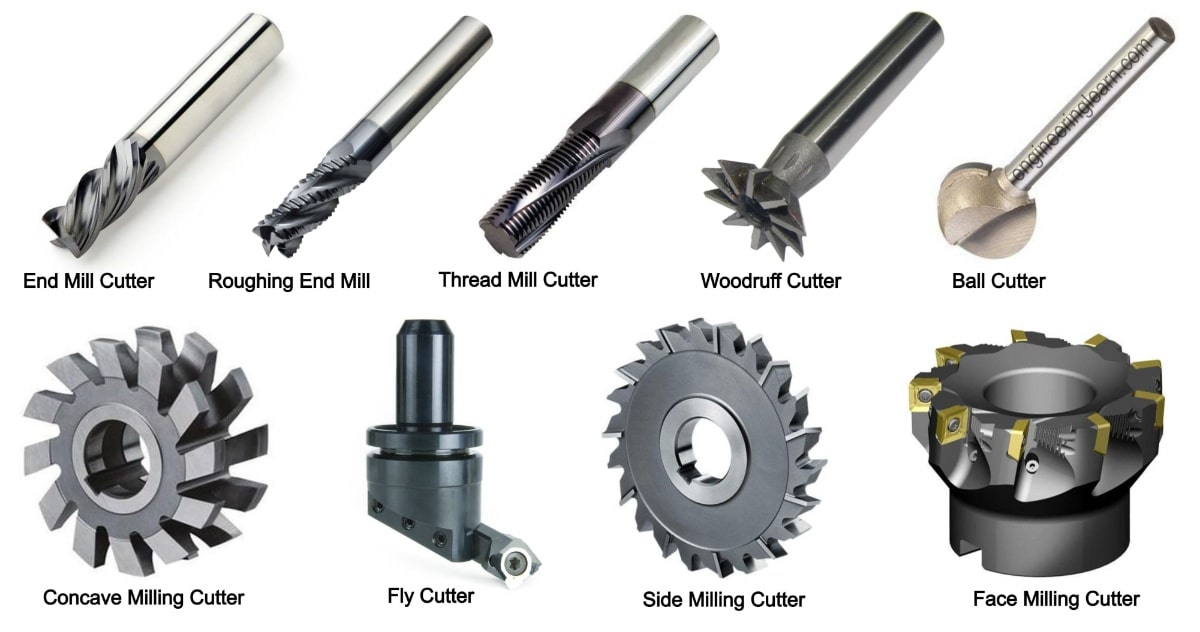A CNC milling machine is a tool that a computer controls. It is used to cut and shape various kinds of materials like metal, wood, and plastic. CNC machines are accurate and work efficiently, lowering the overall cost of the process.
We always look for precision and the right outcomes, CNC milling machine helps you attain them. It ensures the finished product matches the exact specifications we need.
Before moving forward how many CNC milling machine operations exist, and how to learn them? Let’s learn about the basics of CNC milling machines.

CNC milling machines are commonly used CNC machines used to drill and cut shapes into hard materials. The cuts are called ‘milling.’
The cutting tool of the machine stays in one place, and the material to be cut moves in different directions. This movement happens in X, Y, and Z directions back and forth, side to side, and up and down.
The major function of the CNC milling machine is to make custom parts. It removes material from the workpiece by rotating the cutting tool. The machine movements are controlled by the digital data given to the computer.
As CNC milling machines are versatile, they have numerous applications in woodworking, automotive, electrical work, and more.
Now, let’s get into the depth of CNC milling machine operations, how many operations exist, and how to learn them.

How many operations does a CNC Milling machine have? Well, we'll look into 15 types of milling machine operations in detail now.
Face milling is one the simplest forms of milling operations. It involves cutting material from the face of a workpiece to create a smooth flat surface. A face milling cutter is used to perform face milling with cutting edges on the periphery and also on the face of the cutter.
It is mostly used on flat surfaces perpendicular to the axis of the milling cutter. It removes the material while rotating the tool in a clockwise direction. It can be set up on a vertical or horizontal machine with the cutter mounted on a stub arbor.
Plain milling, also known as surface milling, is a column and knee operation used for milling plain surfaces. It involves removing material from the workpiece’s surface using the cutter with multiple teeth.
Plain milling is done on a horizontal machine, with the plain milling cutter securely positioned on an arbor. To achieve the desired depth of cut, the operator adjusts the vertical feed screw by raising the table.
Once the appropriate feed rate and cutting speed have been determined, the table is moved along the X-axis, allowing the rotating cutter to remove material from the workpiece.
If you want to create a flat vertical surface on the workpiece, side milling comes into use. The cutting tool is attached to the horizontal arbor. The table is adjusted to attain the milling depth for vertical features.
Choosing the milling cutter’s size, diameter, and type depends on your machining task.
Tip: Pick the cutter with the smallest diameter to ensure the effectiveness of the task.
If you want to cut two or more parallel vertical surfaces in one cute, straddle milling is used. Mount two side milling cutters on a horizontal machine on the same arbor.
With the same dimensions as the parallel sides, a spacing collar keeps cutters apart. It is done to straddle the workpiece to produce a flat vertical surface.
Straddle milling has applications in cutting splines, squares, or a hexagon on the end of a round part.
Gang milling involves using multiple milling cutters mounted on the same arbor to cut multiple surfaces simultaneously. It is used to produce complex shapes in a single setup. It also reduces machining time and increases productivity.
In gang milling, the arbor holds multiple cutters in the same plane, usually of the same size and type. These cutters can be mounted to single or multiple spindles using varying arbor configurations.
The workpiece on the machine’s table moves beneath the cutters and gets the desired shape accordingly.
In this type of milling operation of CNC milling, the cutter is set at an angle to the workpiece surface that removes the material at an angle other than perpendicular to the workpiece. Angle milling produces tapered surfaces, bevels, chamfers, and more.
It involves adjusting the machine’s worktable or workpiece at a desired angle. The milling cutter, an end mill, or any other type is positioned and locked at the specified angle.
Form milling involves cutting the workpiece using a specially designed milling cutter or form cutter. It is customized to create a specific shape on the workpiece that allows the production of specific features.
In it, the milling cutter is ground to the exact shape of the contour to be machined on the workpiece. Depending on how complex the shape is, the cutter may have multiple cutting edges.
The machine’s workpiece is moved precisely based on the milling cutter’s contour during the process. The cutter follows the path in which the shape is to be cut.
This operation creates flat surfaces, slots, and other features at the end of a workpiece. It is one of the fundamental milling processes and involves using an end mill.
The process starts with a workpiece clamped on the milling machine table. The end mill is mounted in the spindle of the milling machine. The cutting edge of the end mill removes the material from the workpiece to produce the desired shape and cuts.
End milling can be performed in various directions, including face, plunge, and peripheral milling.
Our discussion of milling operations cannot be completed without discussing conventional and climb milling operations. They both are distinctive types of milling operations; let’s discuss them.
Conventional milling is also known as against-the-feed milling. In it, the milling cutter rotates against the direction of the workpiece movement. The cutting starts at the thickest part and gradually decreases.
Climb milling is also known as down milling. The cutter rotates in the same direction as the workpiece movement. The cutting starts with the chip gradually increasing its thickness as the process continues.
Conventional milling does not cause chatter, making it a perfect choice for heavy deep cuts. But you may create a rough surface finish. On the other hand, Climb milling produces a better finish and requires less cutting force, making it a better option for less rigid setups.
Sawmilling is also known as wood milling. It is used to convert logs into various wood products. Sawmilling has a wide variety of applications in the wood industry. It provides raw materials for construction, furniture making, and more.
The sawmilling process usually comprises the following: log handling, debarking, log positioning, sawing, edging, grading, dying, and finally, stacking and packaging.
Milling keyways, grooves, and slots are used to create specific features on the workpiece. Keyways are slots or grooves cut into shafts or hubs to accommodate keys. Grooves are elongated slots on the surface of a workpiece. They provide clearance for O-rings, housing seals, or other components.
It is a specialized machining process used to manufacture gears. Gears are widely used in automotive, aerospace, robotics, and many other industries. There are various methods for gear cutting, including gear hobbing, gear shaping, gear grinding and milling, and gear lapping.
The type used depends on the gear size, requirements, production, and available equipment. Gear cutting requires specialized machinery and skilled operators to produce precise and reliable gear.
It creates external or internal threads on a workpiece using a milling cutter. It is an alternative method to traditional thread-cutting processes like tapping. The milling operation of a CNC milling machine offers flexibility, precision, and the ability to produce various thread sizes and forms.
It also has applications in various industries, including automotive, medical, and general engineering.
It is another CNC milling machine used to create cam profiles on the workpiece. A cam is a mechanical component that converts rotary and linear motion into one another. Cam profiles are widely used in mechanical systems, including engines and pumps, to achieve desired motion patterns.
The process starts when the workpiece is mounted on the machine’s table. Then, a specially designed cam milling cutter is used to create the cam profile.
Cam milling requires precision machining and careful control over the milling machine's movements. Cam milling is critical in the design and manufacturing of various mechanical systems.
CNC milling is a manufacturing process that utilizes computerized controls and cutting tools to remove material from a workpiece.
CNC Milling produces complicated parts for industries using subtractive machine technology. The milling machine cuts the workpiece and crafts the final piece using 3, 4, or 5 axes.
The complexity of the final piece depends on the number of axes the machine has. Hence, it has various applications in medicine as well as aerospace industries.
Learning CNC operations is not so complicated, but it takes time and consistent effort. Also, you must know CNC machine components to start learning the operations. Let’s look at the track by making it a step-by-step guide.
1. Enrol in the class: If you acquire a high school diploma, you can join a class learning CNC milling operations.
2. Get trained: After completing the course, you must acquire hands-on experience. And this can be gained by joining a local manufacturer to enroll in the training program. You should continue training for at least 6 to 12 months.
3. Apply for the job: Once you have completed your course and training, update your CV and check local job boards such as LinkedIn or Indeed to get a job.
The time it takes to learn CNC milling operations depends on various factors, including prior experience, knowledge, and complexity.
If you are already familiar with the basics of a CNC machine and its components, it may take a year or 2 to learn the operations. But if you’re a beginner starting from scratch, becoming a qualified professional may take 3 to 5 years.
CNC milling machines are versatile tools used in various industries for precision machining. They are capable of producing complex and intricate parts with high accuracy. Several types of CNC milling machines are designed for specific purposes and applications. Here are some common types:
A VMC is one of the most common CNC milling machines. The spindle axis is vertically oriented, and the cutting tool moves along the Z-axis while the workpiece is stationary on the table. These machines are suitable for producing flat surfaces and 3D shapes.

An HMC has a horizontally oriented spindle, and the workpiece is placed on a rotary table that allows multi-sided machining without the need for repositioning the workpiece. This setup is beneficial for high-volume production and heavy-cutting applications.
5-axis CNC machines have the capability to move the cutting tool along five axes simultaneously. These axes are typically X, Y, Z, and two rotational axes, usually called A and B. This enables the machine to create complex geometries and intricate parts with fewer setups, improving accuracy and reducing production time.
Like 5-axis machines, 6-axis CNC machining centers add another rotational axis, usually called C. These machines offer even more flexibility, allowing for highly complex and contoured shapes to be machined.
A bed mill is a type of CNC milling machine with a bed-shaped base structure. The cutting tool moves along the X and Y axes, while the spindle moves along the Z-axis. These machines are often used for heavy-duty cutting and large workpieces.
Other types include gantry milling machines, CNC engraving machines, and CNC drilling machines.
CNC milling is a versatile machining process used for a wide range of materials across various industries. It is suitable for metals like aluminum, steel, brass, and titanium, offering precision cutting for aerospace, automotive, and medical applications.
Plastics such as acrylic, polycarbonate, ABS, and nylon are easily shaped for consumer products and electronics—woodworking applications, including furniture and cabinetry, benefit from CNC milling's accuracy.
Composites like carbon fiber and fiberglass find use in aerospace and sports equipment due to their strength and lightness. Additionally, ceramics, foam, glass, and stone can be intricately shaped for electronics, art, and architecture.
CNC milling's adaptability, precision, and repeatability make it an ideal choice for manufacturing complex parts and components in various materials.
Milling cutters are rotary tools used in CNC machines and traditional milling operations to remove material from a workpiece. Various types of milling cutters are designed for specific cutting tasks and materials. Here are some common types:
The most commonly used milling cutter, an end mill, has cutting teeth on the end and periphery. It is used for side milling, profile milling, and plunging. End mills come in various configurations, such as square end, ball nose, and corner radius.
Face mills have cutting teeth on the face and periphery. They are used for facing large flat areas on the workpiece and are ideal for high material removal rates.
Ball nose cutters have rounded ends, making them suitable for 3D contouring and sculpting curved surfaces.
Slab mills are large-diameter cutters primarily used for machining large flat surfaces.
T-slot cutters are used to machine T-shaped slots in machine tool tables and workpieces, allowing for securing work-holding fixtures.
There’re other types of cutters, including fly, chamfer, woodruff, and more.

This article covers types of CNC milling machine operations and how many types exist. How you can learn and understand them in detail.
The milling machine operations include face milling, plain milling, side milling, straddle milling, gang milling, angle milling, form milling, end milling, conventional and climb milling, sawmilling, milling keyways, grooves, and slots, gear cutting, thread milling, cam milling, and the CNC milling.
Then comes the guide on how to learn the CNC milling machine operations. The article concludes with the advantages of CNC milling in the production process.
If you also are looking for an excellent CNC milling machine for greater efficiency, look no further and get a CNC milling machine based on your requirements and desire from Yangsen!
Have you got more questions related to CNC milling machine operations? Here’re the answers to the most frequently asked questions.
How many operations does a CNC milling machine have?
Fifteen types of CNC milling operations are used mostly. You can check them in detail above in the article.
What is the CNC milling machine used for
It is used to machine flat and irregularly shaped surfaces and to drill, bore, and cut gears, threads, and slots.
How to learn CNC machining?
Enrol in the course, get trained and then apply for the job on local job boards. This has been explained in the article above in detail.